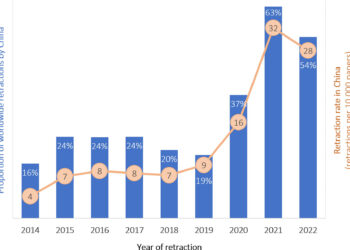As you might expect, I visit a lot of journal Web sites. I acquire cookies from many of these journal sites on my computer. So far, so normal.
Recently, however, I started to see ads from one particular journal following me across the Web, appearing in the oddest and most unexpected locations — on the New York Times, on the Atlantic, and on some other sites that have nothing to do with science, journals, or scholarship.
I was being followed!
From what I could deduce, DoubleClick — a Google property — was enabling this kind of ad following.
This is nothing new for the larger Web. Go to a travel site, and you’ll probably have hotel and airline ads following you soon enough. Go to a cooking site, and ingredients and restaurants will follow you. Go to a shelter site (e.g., Home Depot, Lowe’s), and suddenly faucets and garden tools are in your ads. Telemetry and triangulation are tracing tactics.
Traversing from general property to general property, these ads don’t leap out at you. They’re just kind of there, and could be there by chance or by design. It’s hard to know, and they register as normal or only slightly askew.
The challenge for scholarly publishers is that the zone of professional definition is potentially viewed as more sacrosanct than the zones of entertainment, vacation, hobby, or chore. Years of training, decades of reputation-building, and specialized knowledge sources all factor into a separate professional identity. To have markers from that identity popping up where you least expect it — well, it’s potentially jarring.
You may be a Red Sox fan and a cardiac surgeon in Boston, but do you really want a heart journal ad popping up on your fantasy baseball site? You might knit on nights you’re not coaxing lab rats along an experimental protocol, but do you want reagent ads popping up on your stitching sites?
Online advertising is a different beast. Facebook and Google are acquiring huge potential advantages in the consumer space because they know so much about us now. Their targeting capabilities are increasing daily. Leverage these completely, and they could shut the door for a decade.
Because online inventory is more finite than print inventory, the ability to advertise across sites will become increasingly important, especially for sites with smaller audiences and flat inventory (based on page views). But if scholarly publishers have perceptual problems advertising into non-scholarly properties — if my experience represents a common feeling others do or will share — their ability to expand their inventory by tracking users outside their sites ends. And that has revenue implications in the long run.
Professional identities among scientists often clash with personal identities. When advertising inadvertently drags the professional into the personal or vice-versa, the experience can be jarring. Because of that, scholarly publishers may have trouble following their users with ads.
Discussion
3 Thoughts on "I'm Being Followed — New Advertising Technologies and User Self-Identity"
Much like other progressive (or aggressive) digital ad tactics, the tabloids in STM are the obvious leaders in “retargeting” and “interest-based” advertising. Unrestricted by membership and subscription models or concerns about a perception of industry collusion they are free to experiment. Within that realm, pushback has been nominal so far. Similarly, there are STM ad networks effectively offering this service internally to their partners and externally to non-network members. As industry marketers care less and less about the environment and more about the demographics of a specific visitor, Scholarly publishers will find themselves, again, well behind the bar required by industry marketers to optimize their media spend. There is a movement afoot through the internet advertising bureau (IAB) to introduce self-regulatory principles including an icon that appears when you have been behaviorally targeted. The icon link allows for both an understanding of how a visitor has been targeting and the opportunity to opt out in the future. A nice compromise. I suspect that vast majority of visitors will accept the jarring experience as the latest evolution in their digital experience and move on.
Another point to consider here is that rather than fencing inventory, scholarly publishers can partner with their competitors making sure that behavioral targeting occurs in a relevant environment. Given the large amount of remnant inventory most publishers have to deal with, reaching across the table can be a win-win.
When selling content to pharma companies, there is often a request for a self-hosted, internal-to-the-company version of the content. This is seen as a means of protecting the company from anyone tracking their reading habits and deducing potential research pathways on which they were working. I’m assuming such companies are not going to be terribly happy with someone tagging and tracking them all over the interent. Perhaps there’s a business opportunity to be had in proxy servers (https://secure.wikimedia.org/wikipedia/en/wiki/Proxy_server)…
I’m a little surprised that this isn’t seen as a benefit. Right now, the people who advertise in (print, humanities and social science) scholarly journals are… other publishers. Pretty much a zero-sum game. To give an example, there is no way that The Home Depot would spend advertising dollars in The Journal of _____ology (no matter how much we tell them about the demographics of our subscribers). But if Joe Academic had just Googled “framing nailers,” there’s now the possibility to feed her an ad for this weekend’s tool specials.
Furthermore, this is a way to bring in advertising revenue with a fairly strong inoculation against accusations of influence on the part of advertisers. Algorithms and user-history may make for odd combinations of home and work (and avocation, hobby, curiosity) identities but it certainly could redound to the advantage of any smaller publisher.
To put things in even starker terms: we’re competing with bloggers for readers’ time and attention (and I do believe that we’re better than them at what we do)–but they’re making money from AdWords and DoubleClick; why shouldn’t we?




